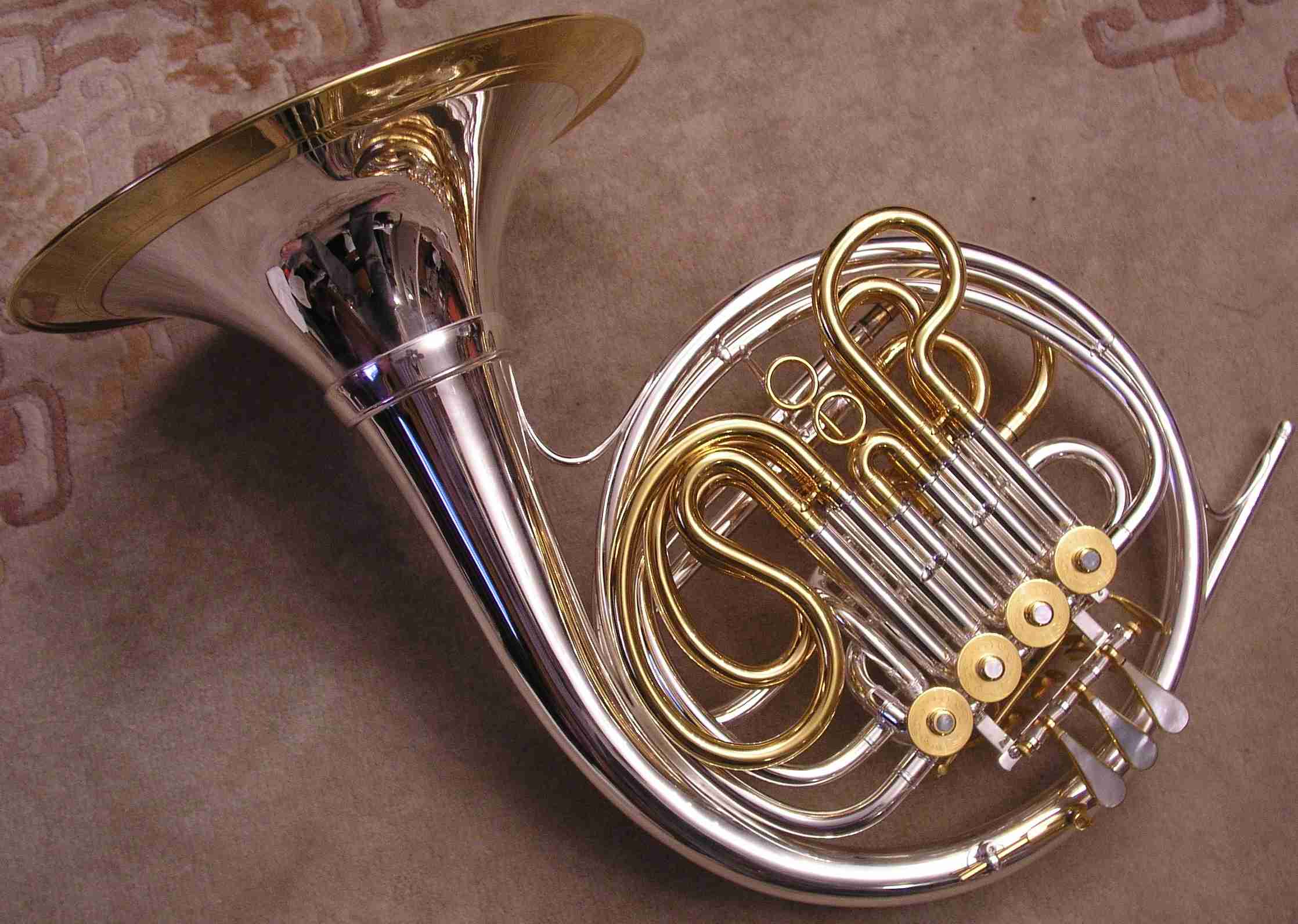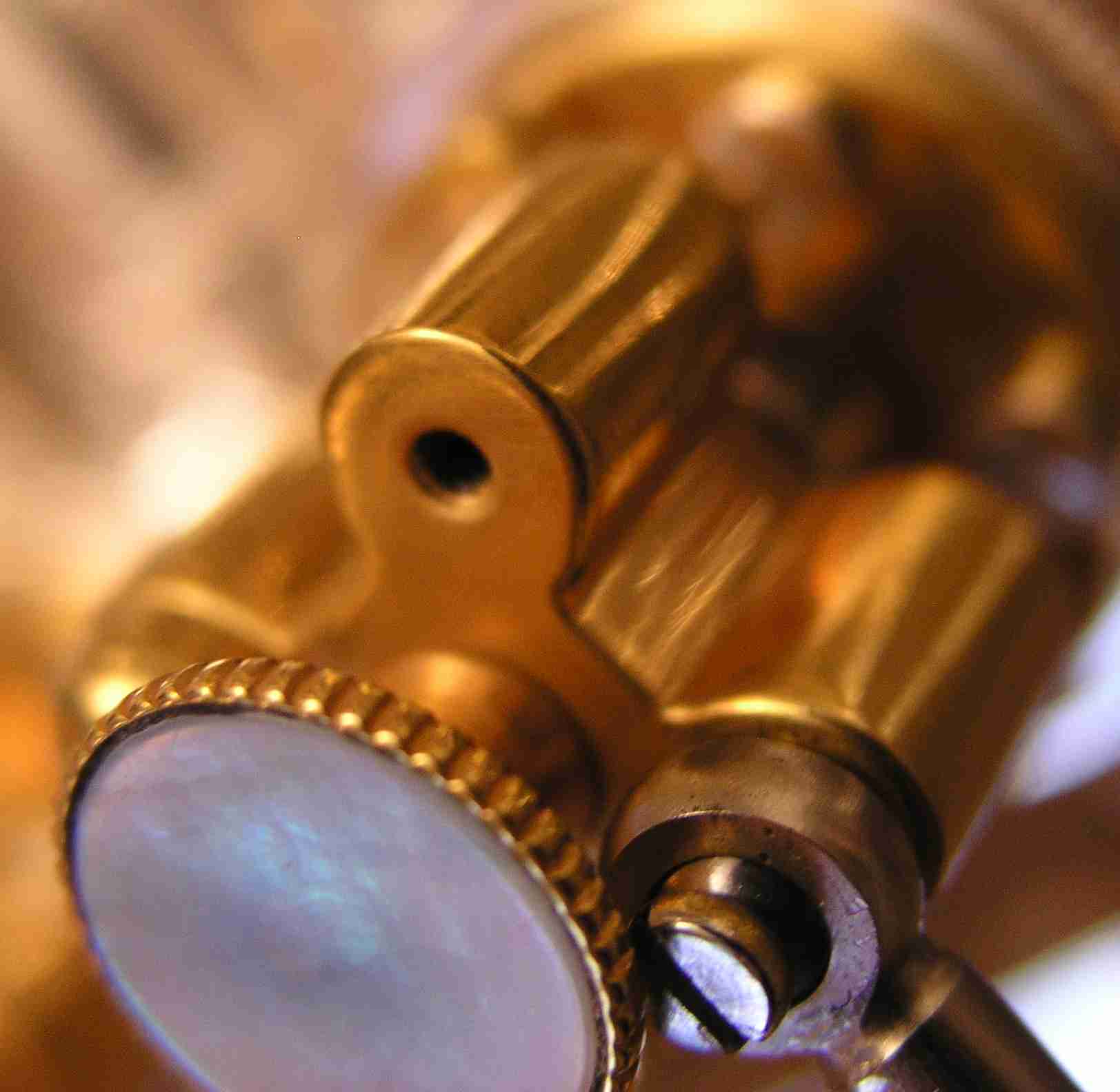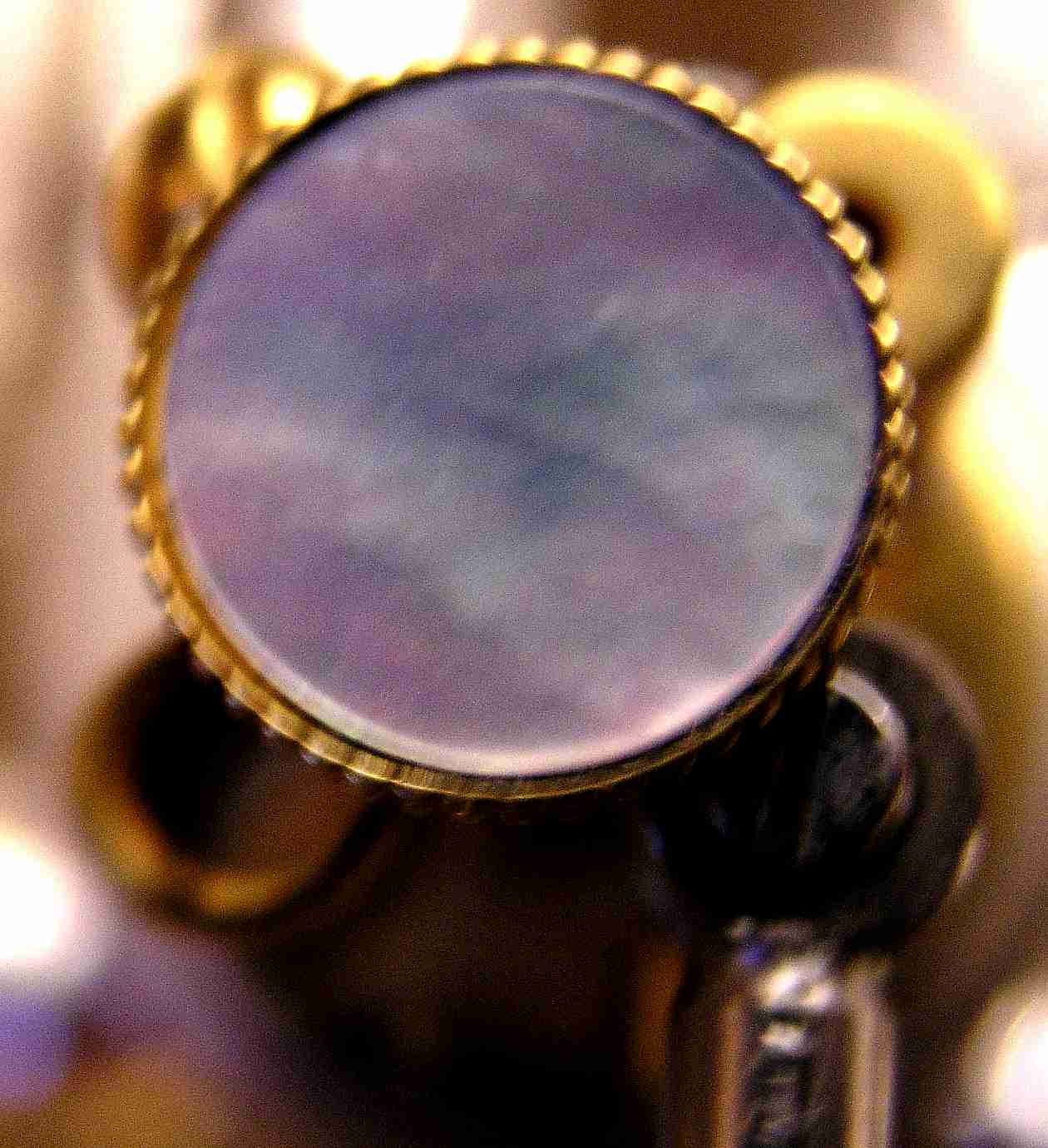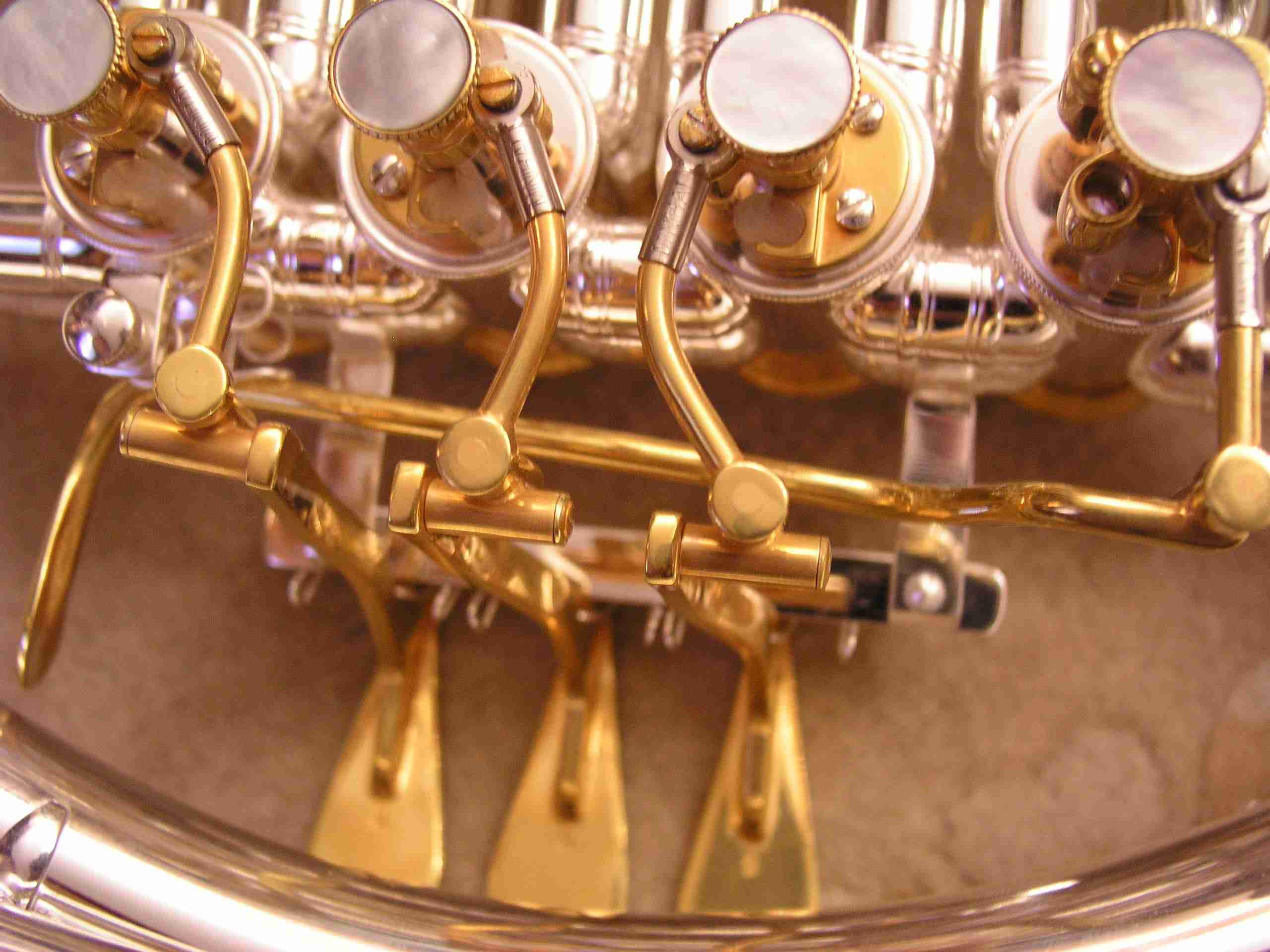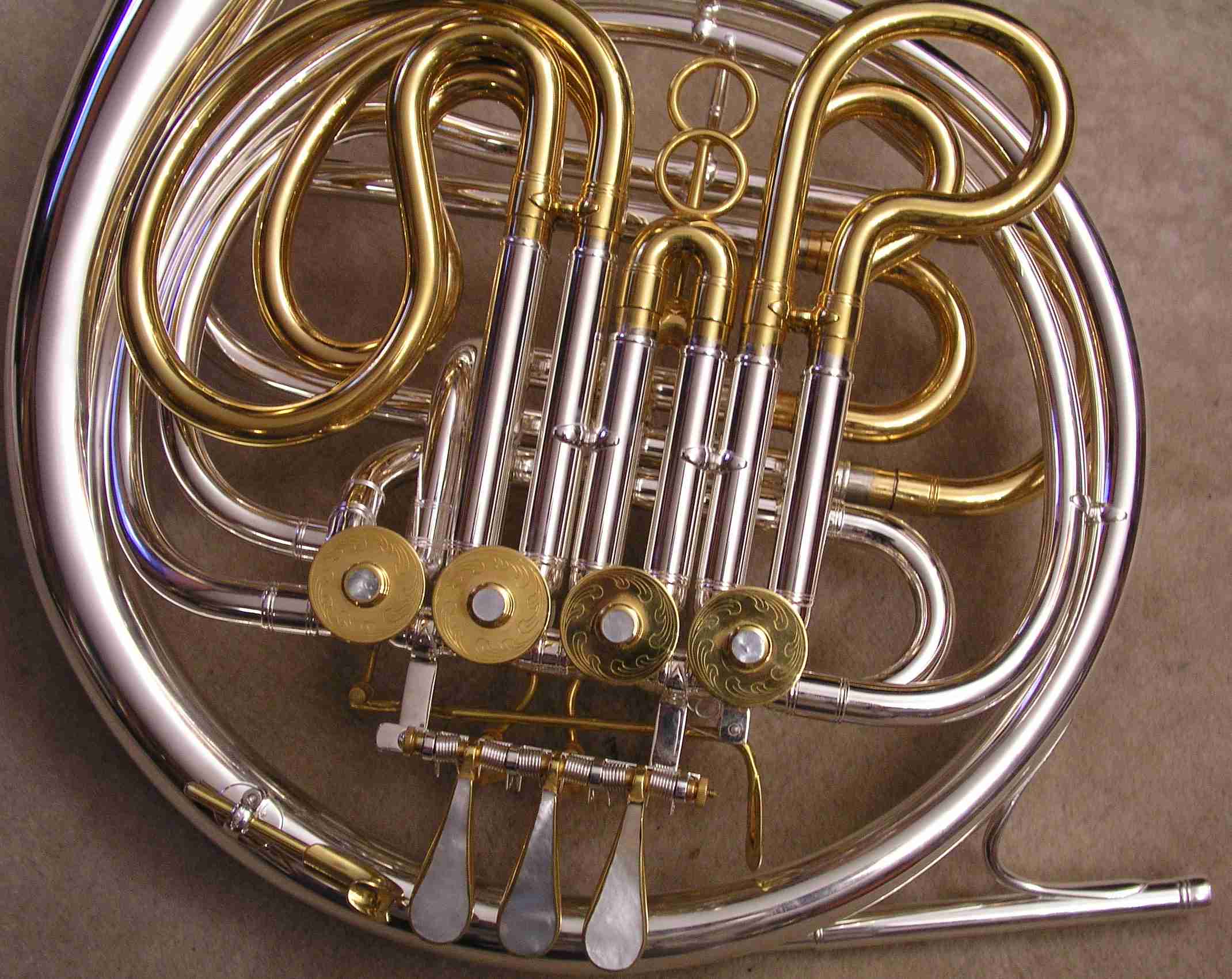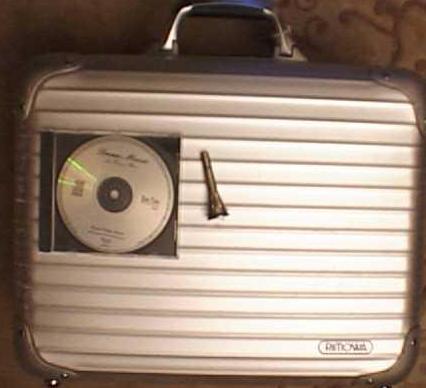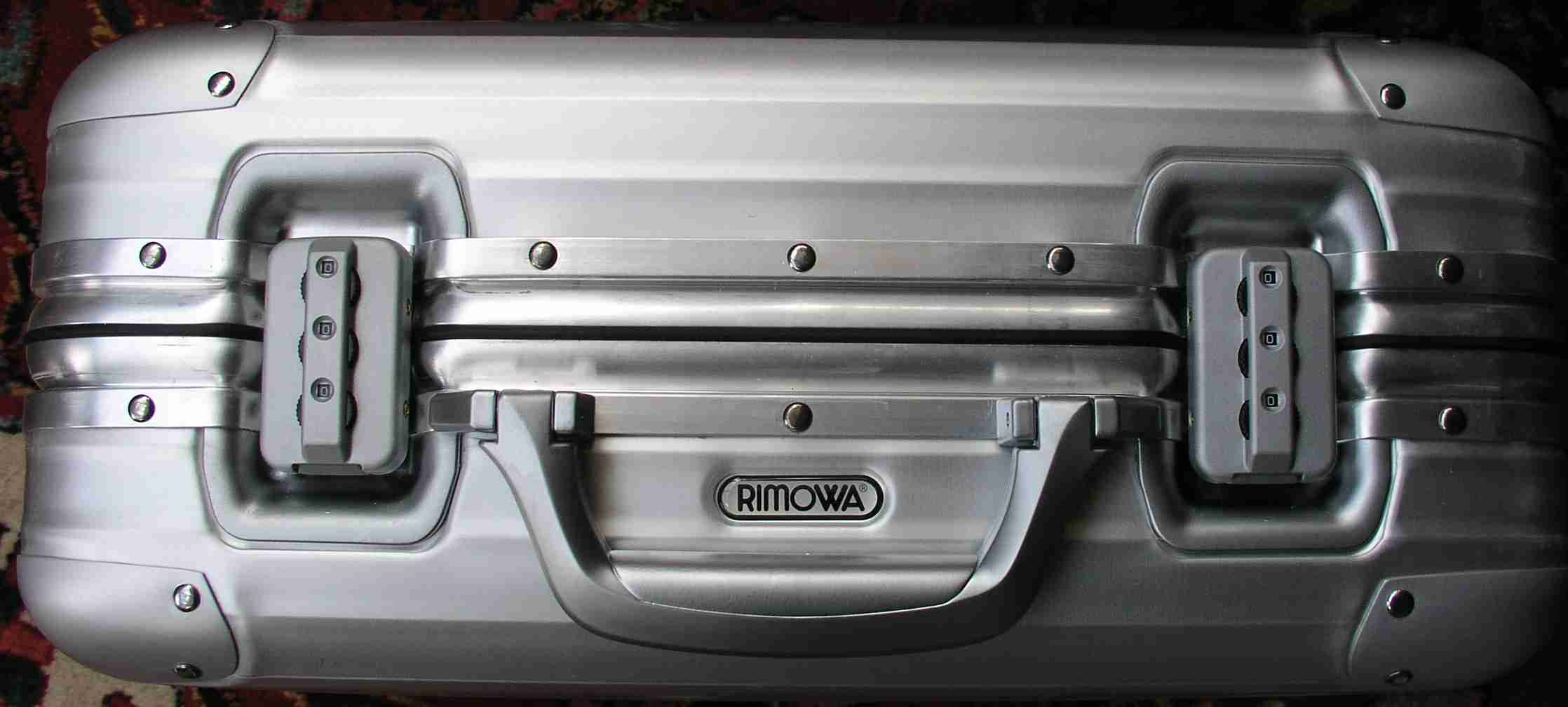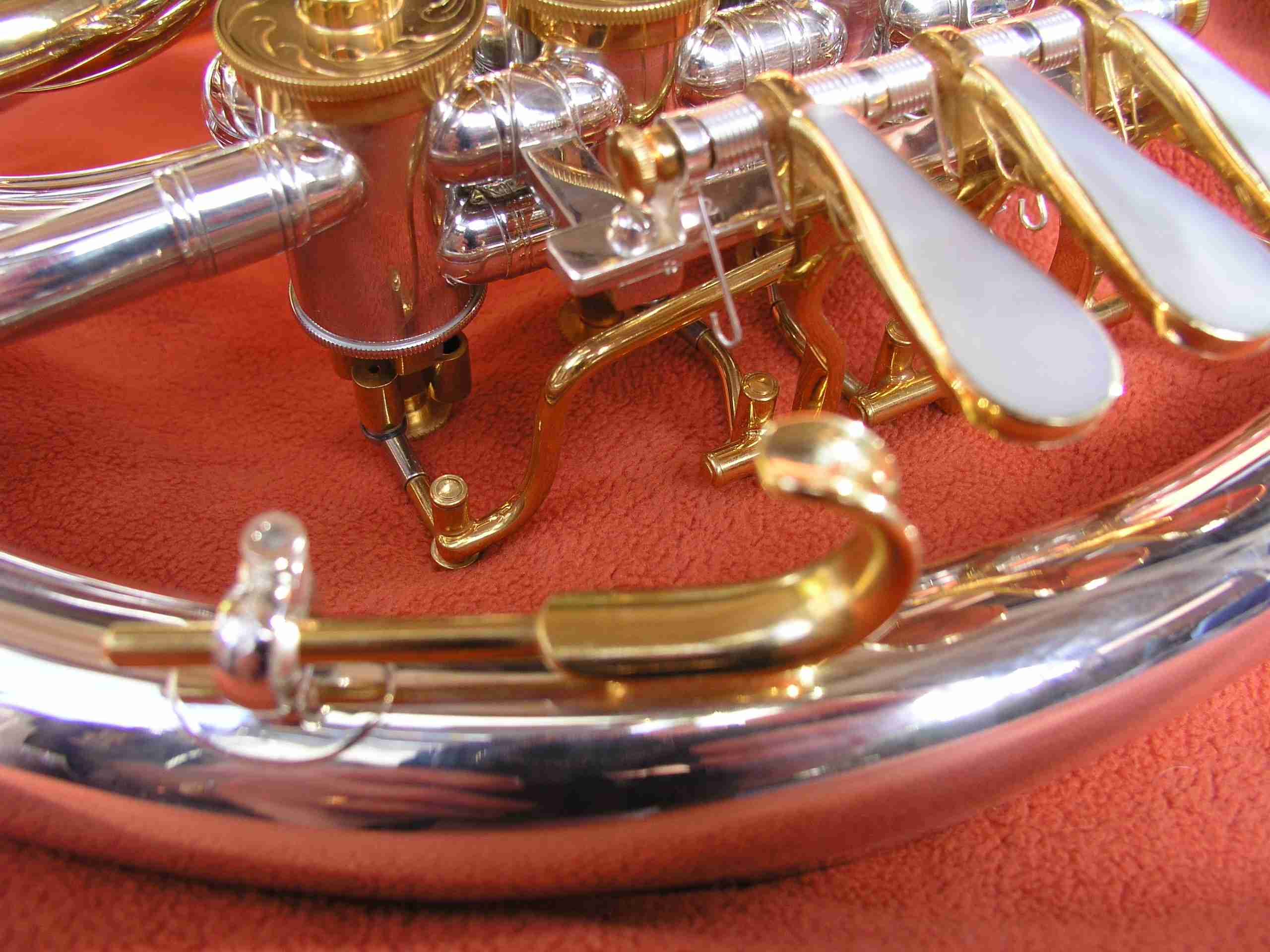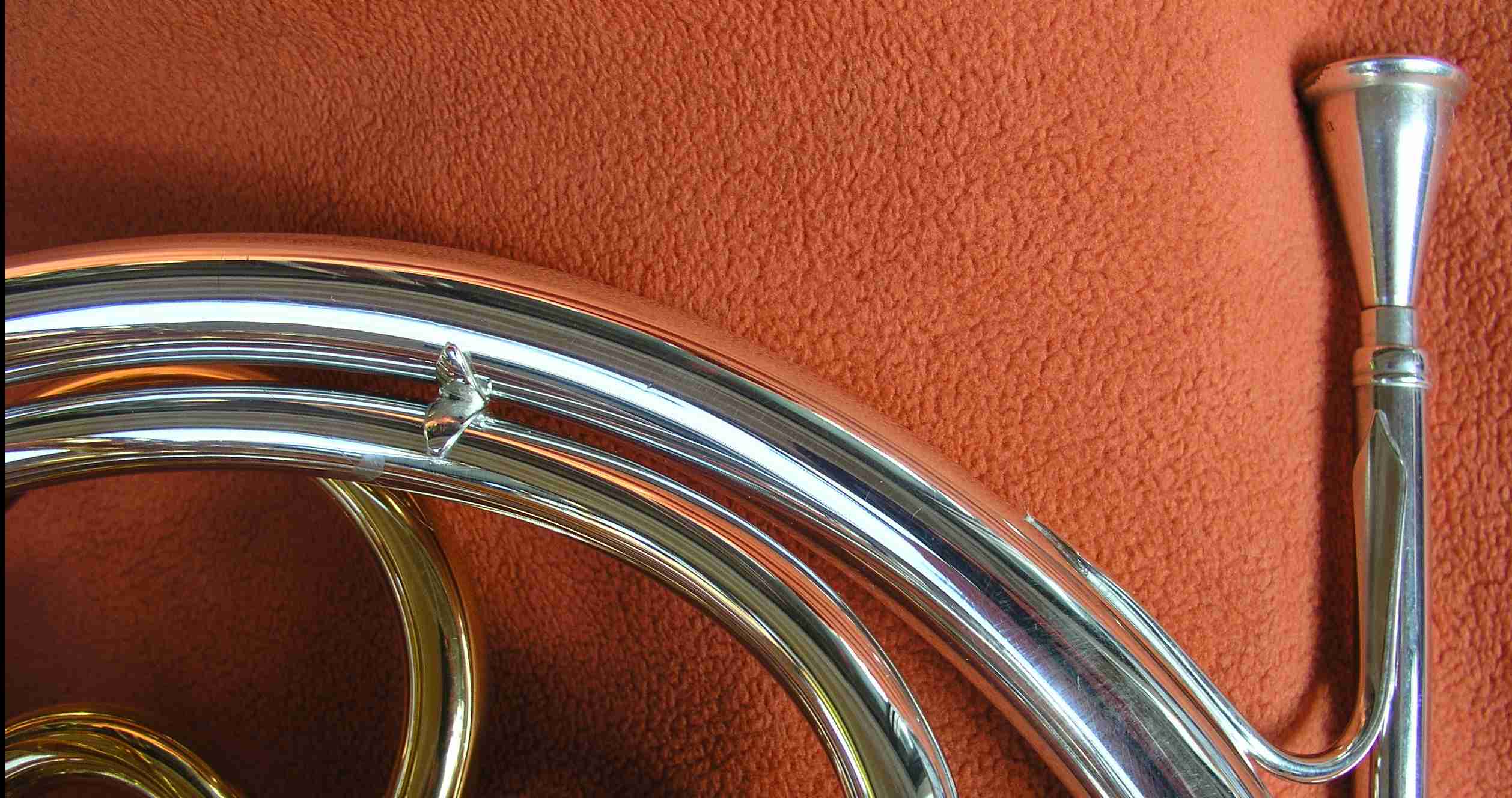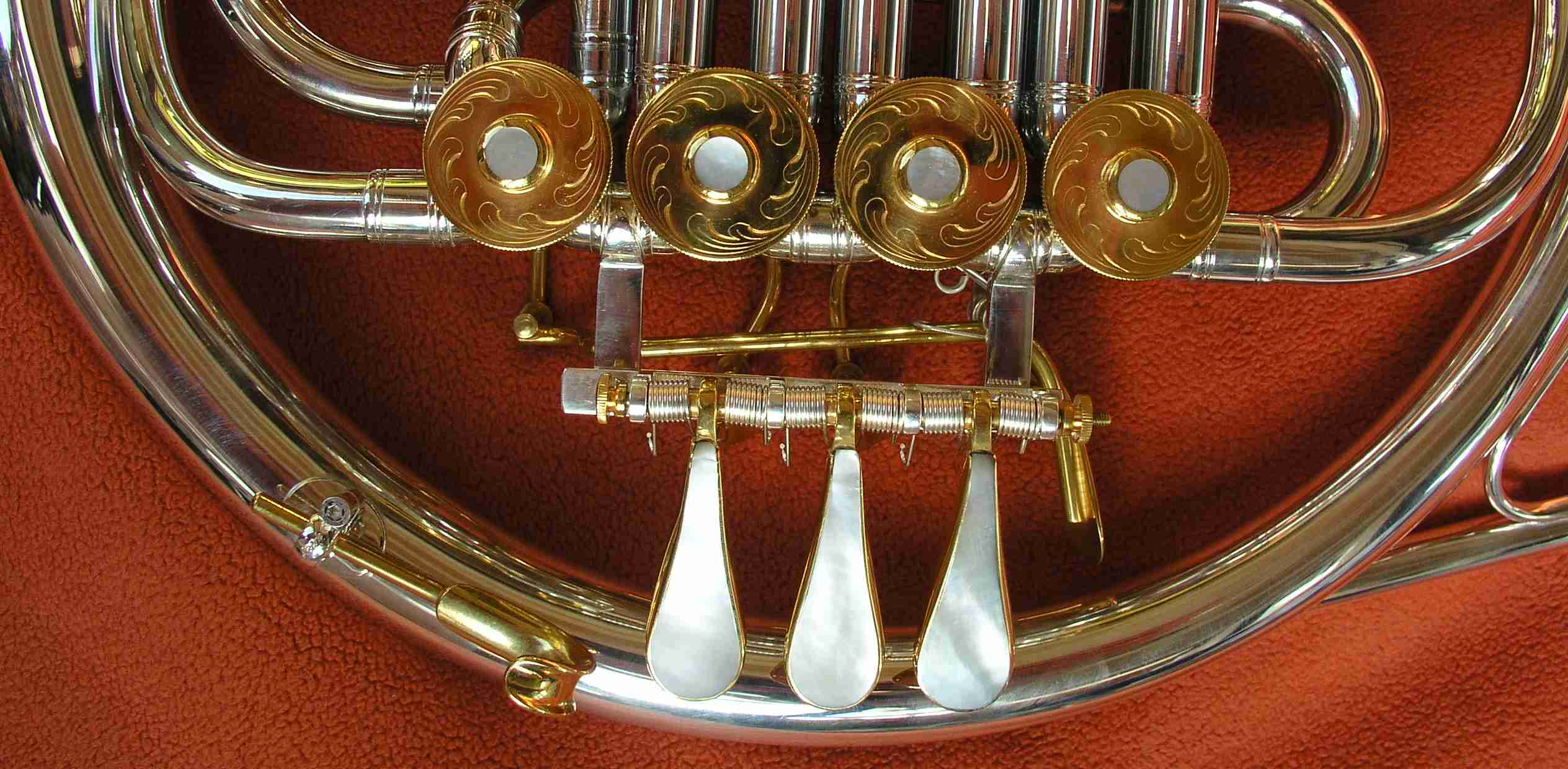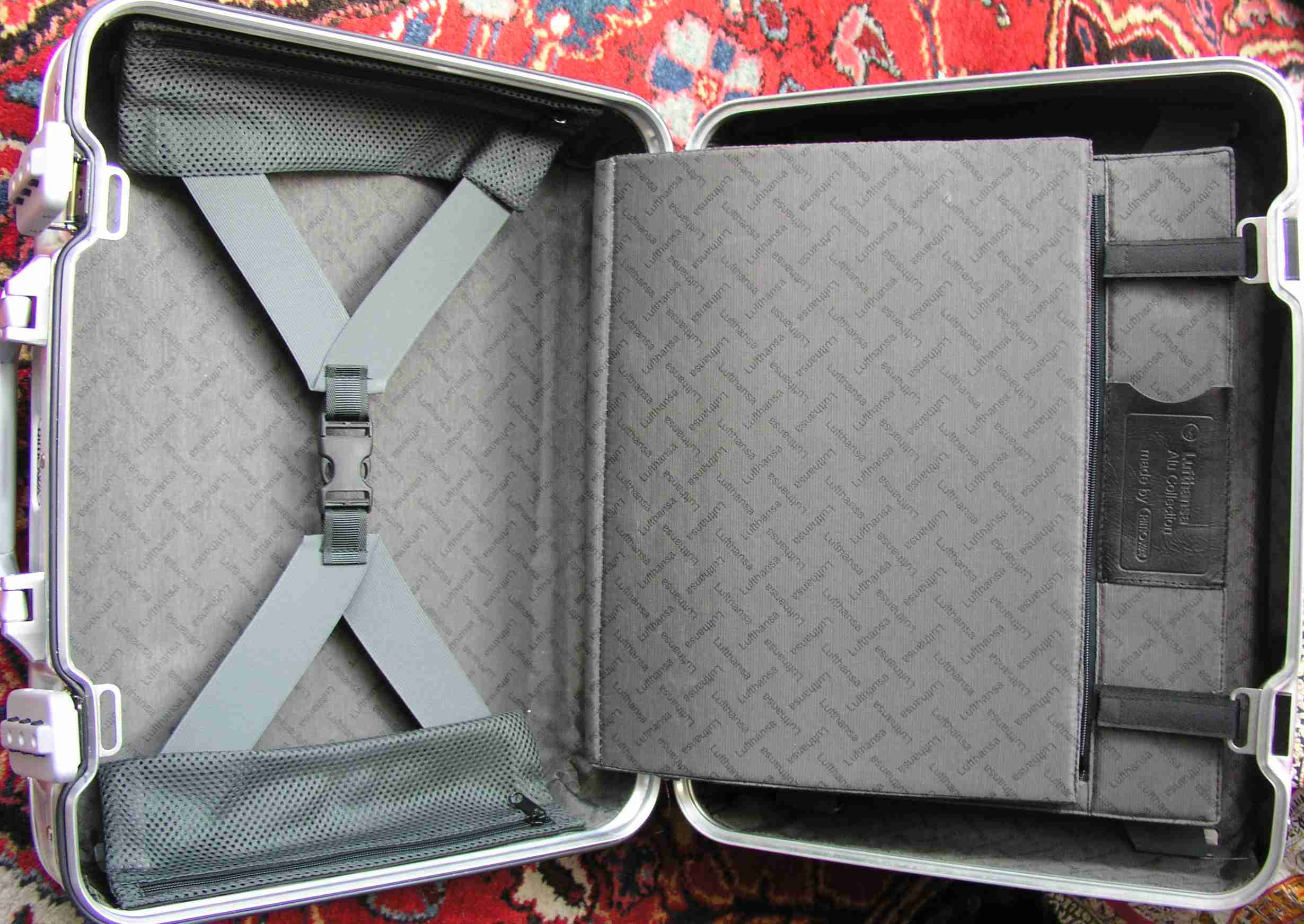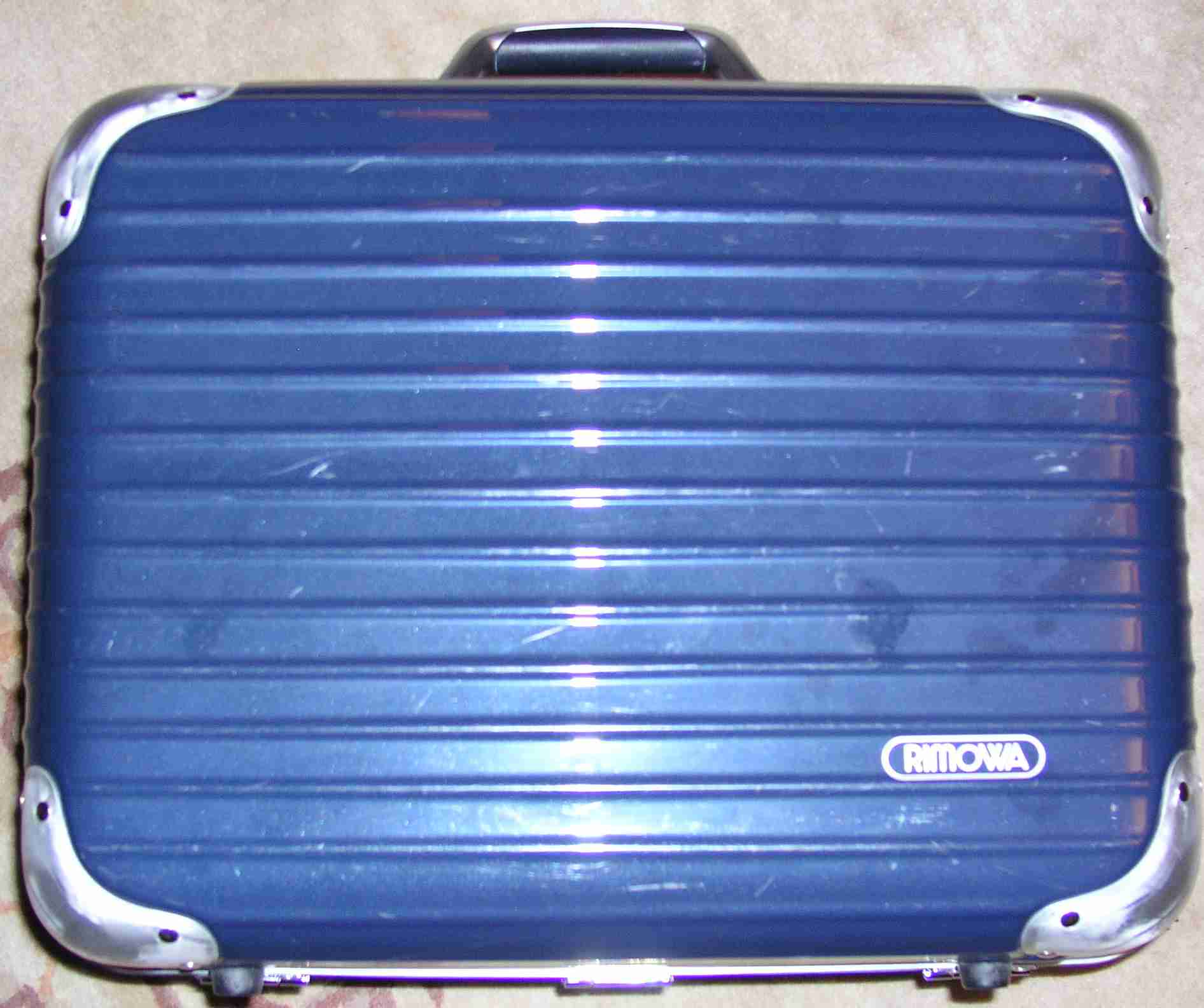| Pizka Classic Double Horns Pizka - Classic ® |
Doppelhörner
|
|
|
The story of this instrument: Some time ago, I decided to join the exclusive club of horn makers by joining the forces of several young masters, to improve my very successful horn, which I had designed by myself about twenty years ago. My horns were made by a long time friend, who has retired from horn making or making other brass instruments since 1992, but he continues with some research in his one room studio to find out more about the "secrets" of the brass instruments, the brass family, undergoing experiments to publish the results in a book about Brassinstrument Making. So his fame will remain alive with those who succeed him with the same passion, taking advantage from his wisdom. He is open for any inquiry regarding his art of brass instrument making, open for anybody. And I will be at your service, passing all inquiries to my friend. Anyway, all of you know, what make of instruments I´ m playing. I designed both of my horns, even made by two different makers. Pizka - Classic ® My Horn maker is the young progressive master Robert Worischek . This horn is real hand made and the tubes are made of sheet metal of best yellow brass , all cylindrical tubes (valve slides etc.) are made of seamless tubes, the extra long lead pipe is made of GBLP gold brass or of SSLP sterling silver (optional for extra 550.- EURO) (I guarantee, that the brass sheet used for the lead pipe has never been cleaned by use of any acidic ! The metal is not stretched or stressed when pressed upon the mandrel, as the lead pipe is not made from ready made tubes, but from specially sheet metal, cut to fit the required dimensions, bent in lead) The bell section is made of a one piece mushroom shaped flat brass sheet, bent together, soldered, softened & brought to the final form by traditional methods. The bending is done traditionally with the lead filled bell section. The total weight of the instrument: 2.750 grs , not the lightest not the heaviest horn. Even the weight, resulting from the 0,45 mms strong sheet metal, which is down at 0,42 mms after the final polishing, has its advantage. It helps preventing the sound from breaking away in the higher dynamics and it makes the horn more resistant against wear. There is a new feature on this horn: the lead pipe is shortened at the front end so to force the player to hold the horn more upright resulting in a better angle between the lead pipe-mouthpiece-axis and the teeth. The mouth piece pressure against the lips is better balanced. Wonder, how the sound will improve by this trick. The yellow brass lead pipe will produce a very mellow sound, while the sound of the nickel silver lead pipe is more penetrating in the higher dynamics but still extremely soft when necessary, the sterling silver gives the shiny velvet sound, which I prefer, but requires a bit more work for the first four weeks. The extreme tightness of the valves might result to make them stick if the instrument is not used for several days. But a light moving on the little wings on the valves back side will bring life to the valve immediately even without using any lubricant. Before laying down the horn for several days, it is recommended to water empty the horn completely and to oil the valves a bit. Your horn will be most thankful for this care. The horn comes with some nice decorations, as the valve keys are with mother-of-pearl inlay & will not become slippery during the concert even in a very hot area. The valve cap nipples & the back screws have the same decoration. All at no extra charge. An adjustable finger hook is part of the standard version.
Instead of lacquering the horn we use polished silver & gold plating for € (EURO) 700.- + VAT supplement charge where applicable. The silverplating has the advantage of much better sound projection & more brilliance besides the phantastic appearance as a real jewel.
I use an 23 years old horn of that type with the traditional valve material extensively, but never had any valve problems. The valves are absolutely tight as on the first day. And I use also a horn with titanium valves. All future horns will be made with the same superb special yellow brass rotors as I have in my main solo horn. This horn provides an F-side, which will make the B-flat players be ashamed, as they can hardly match this extreme light sound (for your Mozart performances) or this very compact thundering heroic Wagner sound, without fat. And for the very delicate or exposed parts ? Well, there is the thumb valve, to switch to the B-flat. And the d2 never more too sharp (comb. of 1 + 2 on the B-flat or third valve on the B-flat resulting in a lowd2), if played as an open note on the F-horn. The g1 is perfectly in pitch on the F-side and very good with 1st valve on the Bb-horn also or with the usual combination of 1st plus 3rd valve. The c1 on the F-side is not as rough as on the B-flat, but even more compact & not "clouded", so one can hit it really, also the g below space (also on the F-side) and the low c. The f2, mostly too flat on the B-flat side, if played as open note, is superb on the F-side, but also superlative on the B-flat if played with the first valve (if you prefer to play it as an open note of the Bb-horn, do so & be surprised about the excellent intonation!), etc. etc. more advantages. You cannot" over blow" this horn (you know, this vibration noise in the extreme forte range) as the nickel silver garland works as the "fortissimo-break" , allowing the loudest forte you ever heard, - but with quality.
To change this horn from the F/Bb system to Bb/F system is no nightmare, but only a matter of lose two screws place them forward into two alternative holes & tighten. Very simple solution. The middle register is even mellower than on a Viennese Pumpen horn, the B-flat side sounds nearly like the F-side, hard to distinguish the difference, well, if you use the right, the classical Viennese mouthpiece also.
A most compact aluminium super light flat case , not much bigger than a case for a bigger size note book, will be available also. Dimensions: 45x35x20cms(17,6 x14,8x 8,5"). Isn't that ideal compact ? The weight of the case ? Just 2.100 grs (approximately 70 ounces or 4 pounds and 3 1/3 ounces). So the horn & the case will fit
into the 5 kgs (ten pounds weight) regulations easily with a weight of
less than 4.800 grs. It is an IATA bord-case , fitting all airline
regulations for under the seat luggage. It is even smaller than the
regulations would allow. The design will vary from time to time depending
upon the availability of certain models, but anyway be similar, of the
same size & QUALITY. I just got some of these
RIMOWA super compact cases, but in dark green, dark blue & black only. No
more silver at this moment. But available with the next horns from
September 2004. Silver case in Lufthansa design will be for sale. They
bear the LUFTHANSA logo.
I promise, to play all single instruments in real performances of the Bavarian State Opera or during my solo concerts, to guarantee the extreme high standard of these horns. It is not a horn for the average player, but we would be happy, if more would like to return to the real smooth but also heroic sound of the horn. This horn would be the right tool to achieve this goal. Some might call it a peashooter, because of the slim lead pipe, why not. Not everybody could (and should) sound like me or like Tuckwell or Clevenger or Baumann or Damm, but similar in sound quality at least. That's it. The price : EURO 5.850.- plus the VAT or customs, if applicable. The price includes the horn, silver & gold plating, screw bell & mother-of-pearl decoration, adjustable finger hook , lead-pipe of goldbrass. In Germany there is a VAT (MWSt.) of 16% applicable to the net price. Please ask your bank for the actual exchange rate. Airfreight will be charged at actual costs kept at the possible minimum. Shipment to the USA will be made via NIPPON EXPRESS/FedEx & should arrive within four / five days. Fastest was 24 hours. The shipment will be fully covered by insurance. Usually shipment: 165.- EURO. The VAT will be changed to 19% soon. Custom processing incl. prepaid custom tax can be arranged & is recommended, so you get the horn home delivered without any hassle. This can be arranged for all countries, but custom percentage will vary (Canada 7% GST, Malaysia 10% VAT, Japan 5% VAT/duty) If the back billing of the US customs is less than what you have paid to me, you will be refunded the excess amount in cash USD. They charge 40.- EURO (50.- USD) sometimes. Take this chance. The super compact aluminium flight case costs me € 250.- net, but is included in the above price. This horn has the real hiss, you know, the special brassy feeling only found with the Viennese horns & on fine old hunting horns. Be surprised by this very special sound, something of the real horn sound . I strongly recommend the silver- & gold plated version. It is really something special & beautiful, but one has to care very much for dents. Every horn is a single piece of the Art of Brass Instrument Making. The valves (uniball only, no string action, sorry !) are absolutely noiseless & will work even after a four week summer lay off. The valves are so fast with their short action, that I had to adjust my playing to cope with this action. I have two of these instruments in use since 15 respectively 10 years, but under extensive hard duty. The valves of the elder horn had been taken out for inspection only once; there was nothing to clean. The other horn still has the valves on their place as they were when I received the horn 1988. This year they will be taken out, as the horn will be re-lacquered, even the lacquer is still nearly perfect after ten years. But I like it super perfect. If it ever happen to you, that a valve string broke just few minutes before a delicate solo or a difficult piece, and you had to struggle to bring the valve back to life, you would never ask for string action again. t happen to me just five minutes before Bruckner no.4 Symphony. So you might understand, why I swear upon ball joint action. My experience with our valvesystem after the summer break: just a short turn with flat-jawed pliers (if necessary) - and it works again perfectly even without oiling or watering before. Everything is traditionally hand made, well, using special tools off course. The single parts are produced in small series for a perfect matching. In the case, something will be broken on your horn, be sure, you will get the exactly matching spare part. They are perfectly calibrated. Email: hans@pizka.de clickhere for
the Sitemap
click
here for
the main index |
contact via Hans.Pizka@t-online.de oder hans@pizka.de address: Prof.Hans Pizka, Postf.1136, D-85541 KIRCHHEIM / GERMANY phone: +49 89 903-9548 fax : +49 89 9039414 your fax will be forwarded to me as email & will reach me everywhere VAT.ID: DE130069455 Tax number: 409/16037 Tax Office Munich IV. Geschichtliches: Vor einiger Zeit entschloß ich mich, dem illustren Kreis der Hornproduzenten beizutreten, indem ich die Talente einiger junger Meister zusammenführte. So wurde das erfolgreiche Horn, das ich 1978 entworfen hatte, weiter verbessert. Bis 1989 wurden die Hörner von meinem lieben Freund gemacht. Seit 1992 ist er im Ruhestand und baut keine Instrumente mehr, forscht jedoch in seiner kleinen Einraum-Werkstatt nach den letzten Geheimnissen unserer Instrumente, der Blechblasinstru-mente. Die Ergebnisse seiner Forschungen wird er in einem Buch über die Herstellung der Blechblasinstrumente veröffentlichen. So wird sein Ruhm als Meister der Zunft bei jenen weiterleben. die mit gleicher Leiden-schaft weiterarbeiten und von seinem Wissen profitieren werden. Außerdem steht er für alle Anfragen die Kunst des Blechblasinstrumentenbaues betreffend jedem zur Verfügung. Anfragen leite ich gerne zur Beantwortung weiter. Pizka-Classic ® Der junge fortschrittliche Meister Robert Worischek baut diese Doppelhörner in meinem Auftrag Dieses Horn ist echte Handarbeit aus bestemMessing , alle zylindrischen Rohre (Ventilzüge) werden aus nahtlosen Rohren in klassischer Wiener Mensur von 10.8 mm (innen) hergestellt. Das extra lange, weit gebogene Mundrohr gibt es aus Goldmessing (ohne Aufpreis), oder in Echtsilber (Aufpreis 550.- EURO). Echtsilber hat den Vorteil der samtweichen Ansprache, verbunden mit dem heroischen Fortissimo. Der Schallbecher wird von der Ventilsektion ausgehend aus einem pilzförmigen Messingblech zusammengebogen, gehämmert und auf die Stahlform aufgebracht. Das Biegen erfolgt in bewährter Art "im Blei". Das Gesamtgewicht des Horns ist um 2.750 gr, somit nicht unbedingt ein Leichtgewicht. Dafür ist es hervorragend ausbalanciert. Das verwendete Messingblech hat eine Anfangsstärke von 0,5 mm, wird aber nach dem Polierprozeß mit nur mehr 0,45 mm gemessen. Das dickere Blech hat denVorteil, ebenso wie der Kranz auf dem Schallbecher, das Wegbrechen des Klanges in den lauteren Dynamikstufen zu verhindern. Außerdem hält das Horn dann wesentlich länger. Es gibt da einige Neuerungen: Das Mundrohr ist am Anfang geringfügig gekürzt. Dadurch wird der Bläser gezwungen, das Horn so zu halten, daß der Winkel zwischen Mundrohr und den Schneidezähnen einem Idealwinkel angenähert wird. So verläuft der Luftstrohm nicht in einem Winkel gegen die Wand des Mundstückes. Der Mundstückdruck auf die Lippen wird besser verteilt. Lassen Sie sich von dem besonderen Klang überraschen.
Da die Ventile absolut dicht sind, kann es vorkommen, dass sie nach mehrtägigem Nichtgebrauch feststecken. Sollten die Ventile fest stehen, dann genügt ein einfaches Drehen am Flügelchen auf der Rückseite, um die volle Funktion auch ohne Öl wieder herzustellen. Das Messingmundrohr erlaubt einen wunderbaren weichen Klang. Mit dem Neusilbermundrohr erreichen Sie einen schärferen Klang in den lauteren Dynamikstufen, behalten aber den weichen Klang im Piano und im Mezzoforte. Das Mundrohr aus Echtsilber ist natürlich das Tüpfelchen auf dem "i" und versieht den weichen Klang noch mit besonderem silbrigem Glanz. Silber hat allerdings die Eigenschaft, etwas langsamer anzusprechen. Deshalb ist eine Einarbeitungsperiode von etwa vier Wochen nötig. Silber ist allerdings auch gegen alle im Instrument oder in der Atemluft auftretenden Säuren resistent. Das Horn ist hübsch mit Perlmutt auf den Griffplatten, den Ventildeckeln und den Rück-schrauben dekoriert. Perlmutt rutscht auch unter "heißen" Bedingungen nicht. Das ist alles im Preis enthalten. Statt lackiert, wird das Horn nur noch glanzversilbert und vergoldet zum Aufpreis von € 700.- + MWSt. wo vorgeschrieben) geliefert.. Das Versilbern bringt den Vorteil der weit besseren Schallabstrahlung und mehr Brillanz im Klang neben dem superben Aussehen - eben ein Schmuckstück.
Das Horn von der Funktion F/B auf B/F umzuschalten ist kein Alptraum. Sie lösen zwei kleine Schrauben, stecken den kleinen Flügel um, schrauben wieder fest - ganz einfach. Ein verstellbarer Haken für den kleinen Finger der linken Hand gehört ab sofort zur Normalausstattung.
Die F-Seite erlaubt einen wunderbaren weichen Klang, der notorischen nur B-Horn-Bläser blamieren kann, da diese kaum diesen extra leichten Klang (für Mozart z.B.) oder den wirklich kompakten donnernden heroischen Wagner Klang, "ohne Fett" auf dem B-Horn erreichen können. Und für delikate oder exponierte Passagen ? Na und, da gibt es dann den Daumenhebel für das B-Horn. Und das d2 ist nie wieder zu hoch (komb. 1 + 2 auf dem B-Horn oder 3 auf dem B-Horn mit den viel zu tiefen d2), wenn es auf dem F-Horn offen gespielt wird (9.Teilton) Das g1 ist auf der F-Seite perfekt und ziemlich gut mit dem 1.Ventil auf dem B-Horn. Das c1 auf der F-Seite ist niemals so rauh wie auf dem B-Horn, vielleicht noch kompakter und nicht so "rauchig". Man kann es also richtig "hinsetzen"; genauso das g unter dem System (also auf der F-Seite) und das tiefe c . Das f2, meist viel zu tief auf dem B-Horn (wenn als offene Note geblasen), ist nun superb auf der F-Seite, aber ebenso superlativ auf dem B-Horn mit dem ersten Ventil (wenn Sie jedoch vorziehen, es wie bisher als offene Note zu blasen, lassen Sie sich von der exzellenten Intonation überraschen !), Sie können das Horn nicht überblasen. Sie wissen schon: diese Vibrationsgeräusche. Der Neusilberkranz und das breite, aber flache Gewinde des Schallbechers wirken als "Fortissimobremse" und verhindern das "Plärren" im echten Forte. Mit diesem Horn können Sie endlich echt laut, aber mit Qualität, blasen. Das mittlere Register ist sogar noch weicher als beim Wienerhorn, die B-Seite klingt fast weich wie ein F-Horn. Wenn Sie dazu ein Wiener Mundstück (siehe weiter unten) verwenden, dann wird der Unterschied zum Wienerhorn fast unhörbar. Jedes Horn ist ein Einzelstück echter Blechblasinstrumentenbaukunst. Ein Meisterstück. Die Ventile sind durch das Uniball-System quasi geräuschlos. Sie funktionieren auch nach dem Sommerurlaub nach kurzem Wässern und etwas Öl sofort wieder. Bei meinen eigenen drei Instrumenten war auch das noch nie notwendig. Beim neuen Instrument kann ein monatliches kurzes Ölen während der ersten sechs Monate nicht schaden. Meine Hörner sind nun schon seit 1983, bzw. 1988, bzw. seit 1998 in ständigem Gebrauch. Eine Wartung der Ventile war auch bei dem ältesten der drei Hörner noch nicht nötig.
Wenn das Instrument voraussichtlich mehrere Tage nicht gebraucht wird, wird dringend empfohlen, das Instrument gut zu „entwässern“ und die Ventile kurz zu ölen. Außerdem ist es günstig, einen oder zwei Ventilzüge herauszuziehen, um eine gewisse „Ventilation“ des Instrumentes zu ermöglichen. Bei längerer „Ablage“ des Instrumentes sollte der Koffer geöffnet bleiben oder das Instrument außerhalb Dieses Horn erlaubt ein echtes "Blech"-Gefühl, Sie wissen schon: der berühmte Klang der Jagdhörner oder im Hornensemble, einfach einen echten Hornklang. Der extra kleine und flache Aluminium Flugkoffer, (Abmessungen : 45x35x20cm) ist im Preis enthalten. Gewicht: Horn und Koffer zusammen unter 4,8 kg. Da gibt es bei Flugreisen keinerlei Schwierigkeiten, da diese Koffer übrigens sogar unter den Sitz passen. Die Silberkoffer tragen das LUFTHANSA Logo.
45 x 35 x 20cms Preis: Natürlich bekommt man das Horn nicht umsonst. Qualität hat ihren Preis. Aber der Preis ist zivilisiert: EURO € 5.850.- plus VAT (Mehrwertsteuer): Versilbern & Vergolden, abschraubbarer Schallbecher, Perlmuttverzierungen (Standard) verstellbarer Fingerhaken (Standard) - Mundrohr aus Goldmessing (Standard, korrosionsfest) Superkompaktkoffer im Wert von EURO € 250.- netto in schwarz, dunkelgrün & dunkelblau & silber = INCLUSIVE . In Deutschland sind es 16% MWSt. auf obigen Nettopreise. Die Mehrwertsteuer ist für alle Kunden aus der Europäischen Union anzuwenden. Bald sind es 19%. Versandkosten als versichertes Postpaket werden in Deutschland nicht berechnet. Für alle übrigen Länder werden die tatsächlichen Versandkosten verrechnet. Diese werden so niedrig wie möglich gehalten. Ich persönlich empfehle das Versilbern und Teilvergolden. Es klingt einfach besser und ist dazu ein besonderes Schmuckstück, das verpflichtet. Natürlich muss man damit vorsichtiger als sonst umgehen, damit Beulen vermieden werden. Wiener Hörner:
PizWrHorns.htm Links: 66 VIENNESE1.htm (Das Wiener Horn) (Viennese Horns) mpiece.htm (Mundstücke) Interessiert Sie die Herstellung der Hörner ? Dann besuchen Sie meine Extraseite und klicken dazu hier (in englischer Sprache und in Deutsch): klicken zur Sitemape (Übersicht http://www.pizka.de/Sitemap.html klicken zum Inhaltsverzeichnis http://www.pizka.de/index.html hier klicken zum Verlagsverzeichnis Kontaktinformation clickhere for the HPE (Hans Pizka Edition) subindex
|
|
|
Viennese Horns:
links see at right above ! interested to watch the horn production ? visit my
|
special page at see other pictures of the double horn at:
|
|
